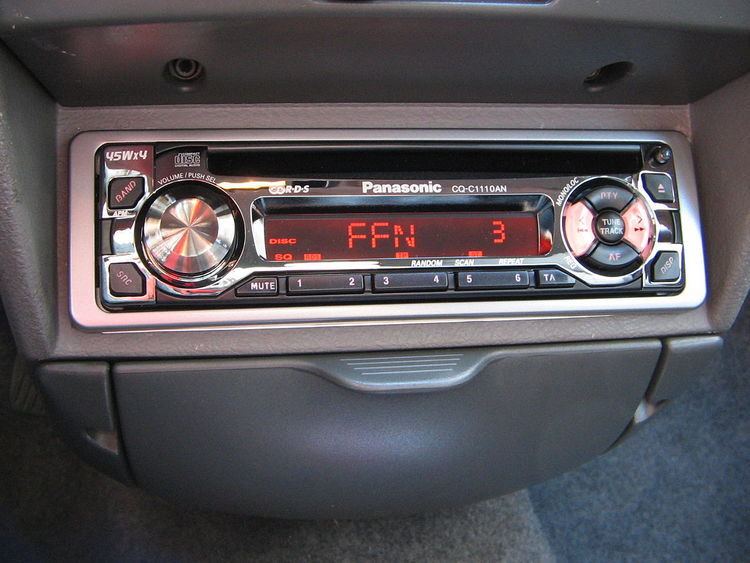 | ||
Vehicle audio is equipment installed in a car or other vehicle to provide in-car entertainment and information for the vehicle occupants. Until the 1950s it consisted of a simple AM radio. Additions since then have included FM radio (1952), CD players (1984), navigation systems, Bluetooth telephone integration, and smartphone controllers like CarPlay and Android Auto. Once controlled from the dashboard with a few buttons, they can now be controlled by steering wheel controls and voice commands.
Contents
Initially implemented for listening to music and radio, vehicle audio is now part of car telematics, telecommunication, in-vehicle security, handsfree calling, navigation, and remote diagnostics systems. It is also used to create fake engine noise. For the 2015 Ford Mustang EcoBoost, an "Active Noise Control" system was developed that amplifies the engine sound through the car speakers. A similar system is used in the F-150 pickup truck. Volkswagen uses a Soundaktor, a special speaker to play sounds in cars such as the Golf GTi and Beetle Turbo. BMW plays a recorded sample of its motors through the car speakers, using a different samples according to the engine’s load and power.
History
Around 1920, vacuum tube technology had matured to the point where the availability of radio receivers made radio broadcasting viable. A technical challenge was that the vacuum tubes in the radio receivers required 50 to 250 volt direct current but car batteries ran at 6V. Voltage was stepped up with a vibrator that provided a pulsating DC which could be converted to a higher voltage with a transformer, rectified, and filtered to create higher-voltage DC.
In 1930, the American Galvin Manufacturing Corporation marketed a Motorola branded radio receiver for $130. It was expensive: the contemporary Ford Model A cost $540. A Plymouth sedan, "wired for Philco Transistone radio without extra cost," is advertised in Ladies' Home Journal in 1931. In 1932 in Germany the Blaupunkt AS 5 medium wave and longwave radio was marketed for 465 Reichsmark, about one third of the price of a small car. Because it took nearly 10 litres of space, it could not be located near the driver, and was operated via a steering wheel remote control. In 1933 Crossley Motors offer a factory fitted car radio. By the late 1930s, push button AM radios were considered a standard feature. In 1946 there were an estimated 9 million AM car radios in use.
An FM receiver was offered by Blaupunkt in 1952. In 1953, Becker introduced the AM/FM Becker Mexico with a Variometer tuner, basically a station-search or scan function.
In April 1955, the Chrysler Corporation had announced that it was offering a Mopar model 914HR branded Philco all transistor car radio, as a $150 option for its 1956 Chrysler and Imperial car models. Chrysler Corporation had decided to discontinue its all transistor car radio option at the end of 1956, due to it being too expensive, and replaced it with a cheaper hybrid (transistors and low voltage vacuum tubes) car radio for its new 1957 car models. In 1963 Becker introduced the Monte Carlo, a tubeless solid state radio, with no vacuum tubes.
In 1964 Philips launched the Compact Cassette, and in 1965 Ford and Motorola jointly introduced the 8-track tape in-car tape player. In subsequent years cassettes supplanted the 8-track, and improved with longer play times, better tape quality, auto-reverse, and Dolby noise reduction. They were popular throughout the 1970s and '80s. While the CD had been on the market since 1982, it was in 1984 that Pioneer introduced the CDX-1, the world's first car CD player. It was known for it's improved sound quality, instant track skipping and the formats increased durability over cassette tapes. Due to the ability that allowed drivers and passengers to change up to 10 CD's at a time, car CD changers started to gain popularity in the late 80's and continuing throughout the 90's. Stock and aftermarket compact disc players began appearing in the late 1980s, competing with the cassette. The first car with an OEM CD player was the 1987 Lincoln Town Car, and the last new cars in the American market to be factory-equipped with a cassette deck in the dashboard was the 2010 Lexus SC430, and the Ford Crown Victoria.
From 1974 to 2005 the Autofahrer-Rundfunk-Informationssystem was used by the German ARD network. Developed jointly by the Institut für Rundfunktechnik and Blaupunkt, it indicated the presence of traffic announcements through manipulation of the 57kHz subcarrier of the station's FM signal. ARI was replaced by the Radio Data System.
In the 2010s new ways to play music came into competition with the CD and FM radio such as internet radio, satellite radio, electrical connectors and Bluetooth connectors for portable media players, and in-dash slots for memory cards. And the automobile head unit became increasingly important as a housing for backup cameras, navigation systems, and displays for smartphones such as CarPlay, Android Auto, and MirrorLink. Some vehicle manufacturers have their own systems for syncing the car with smartphones, for example: BMW Assist, Hyundai Blue Link, iLane, MyFord Touch, Ford SYNC, OnStar, and Toyota Entune.
Components and terms
Legality
Extremely loud sound systems in automobiles may violate the noise ordinance of some municipalities some of which have outlawed them. In 2002, the U.S. Department of Justice issued a guide to police officers on how to deal with problems associated with boom cars. A number of companies have engaged in the irresponsible advertising of high powered automotive audio systems; often, such advertisements encouraged anti-social behaviour such as annoying neighbours when played at a high volume level, including through taglines such as "Turn It Down? I Don’t Think So".
